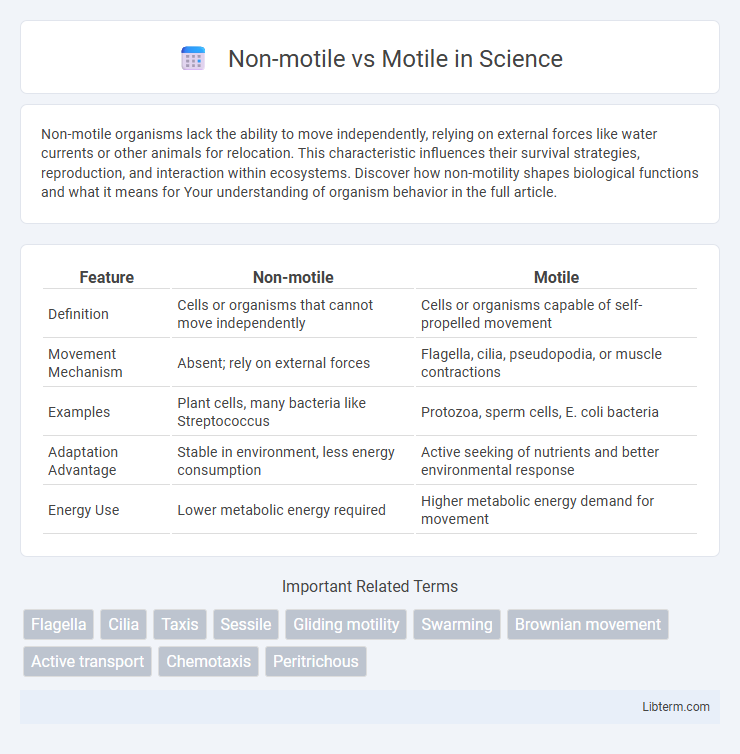Non-motile organisms lack the ability to move independently, relying on external forces like water currents or other animals for relocation. This characteristic influences their survival strategies, reproduction, and interaction within ecosystems. Discover how non-motility shapes biological functions and what it means for Your understanding of organism behavior in the full article.
Table of Comparison
| Feature | Non-motile | Motile |
|---|---|---|
| Definition | Cells or organisms that cannot move independently | Cells or organisms capable of self-propelled movement |
| Movement Mechanism | Absent; rely on external forces | Flagella, cilia, pseudopodia, or muscle contractions |
| Examples | Plant cells, many bacteria like Streptococcus | Protozoa, sperm cells, E. coli bacteria |
| Adaptation Advantage | Stable in environment, less energy consumption | Active seeking of nutrients and better environmental response |
| Energy Use | Lower metabolic energy required | Higher metabolic energy demand for movement |
Introduction to Motility: Defining Motile and Non-motile
Motile organisms possess the ability to move actively using structures such as flagella, cilia, or pseudopodia, enabling them to respond dynamically to environmental stimuli. Non-motile organisms lack these locomotive structures and rely on passive movement, often dependent on external forces like water currents or host organisms. Understanding the distinction between motile and non-motile is crucial in fields such as microbiology, ecology, and cellular biology, where motility influences survival, colonization, and interaction patterns.
Biological Significance of Motility
Motility in biological organisms enables active movement, which is crucial for survival functions such as seeking nutrients, escaping predators, and reproducing. In contrast, non-motile organisms rely on passive dispersal mechanisms, limiting their adaptability and ecological niches. The ability to move enhances evolutionary fitness by facilitating environmental responsiveness and resource acquisition.
Examples of Motile Organisms
Motile organisms exhibit the ability to move actively using specialized structures such as flagella, cilia, or pseudopodia, enabling them to navigate through their environments efficiently. Examples of motile organisms include *Escherichia coli*, which uses flagella for propulsion, *Paramecium* with numerous cilia, and amoebas that move via pseudopodia. These motility mechanisms provide advantages in finding nutrients, escaping predators, and adapting to changing habitats.
Non-motile Organisms: Characteristics and Examples
Non-motile organisms lack the ability to move independently, often relying on external forces like water currents or host movement for relocation. These organisms typically possess structures such as rigid cell walls or specialized attachment mechanisms that facilitate their stationary lifestyle, evident in species like fungi, certain bacteria (e.g., Staphylococcus aureus), and many algae. Their adaptation to non-motility impacts nutrient acquisition, reproduction, and habitat colonization strategies, distinguishing them from motile counterparts.
Cellular Mechanisms Behind Motility
Motile cells utilize specialized cellular structures such as flagella, cilia, and actin-based protrusions like lamellipodia and filopodia to generate movement through coordinated cytoskeletal rearrangements and molecular motor proteins. In contrast, non-motile cells lack these dynamic structures or have limited cytoskeletal remodeling, resulting in stationary behavior and reduced capability for directional migration. The cellular mechanisms behind motility involve ATP-dependent motor proteins like myosin and dynein, which drive cytoskeletal filament sliding and enable cells to respond dynamically to environmental cues.
Evolutionary Advantages of Motility
Motile organisms possess the evolutionary advantage of actively seeking food sources, avoiding predators, and adapting to changing environments, which enhances their survival and reproductive success. Motility allows for efficient colonization of new habitats, increasing genetic diversity and species resilience over time. In contrast, non-motile organisms rely on passive mechanisms for dispersal and resource acquisition, often limiting their ecological niches and adaptability.
Environmental Adaptations in Non-motile Species
Non-motile species exhibit unique environmental adaptations by relying on structural features such as streamlined shapes, adhesive surfaces, or symbiotic relationships to secure resources and survive in their habitats. These species often develop specialized metabolic pathways or dormancy mechanisms to endure fluctuating environmental conditions without the ability to relocate. Their intrinsic ability to optimize local resource utilization and withstand stress contributes significantly to their ecological success in stable or resource-limited environments.
Motility in Microorganisms: Case Studies
Motility in microorganisms plays a crucial role in their survival, influencing nutrient acquisition, colonization, and evasion from hostile environments. Case studies of motile bacteria like Escherichia coli reveal that flagella-driven movement enhances their ability to navigate chemical gradients, promoting infection and biofilm formation. In contrast, non-motile microorganisms often rely on passive dispersal or environmental factors for movement, which can limit their adaptability in dynamic ecosystems.
Non-motile vs Motile: Impact on Survival and Reproduction
Non-motile organisms rely on external forces such as water currents or animal vectors for movement, which can limit their ability to find resources and mates, potentially reducing reproductive success. Motile organisms possess specialized structures like flagella or cilia, enabling active movement to locate food, avoid predators, and enhance mating opportunities, directly improving survival and reproductive rates. The ability to move actively allows motile species to adapt more rapidly to environmental changes, giving them a competitive edge in dynamic ecosystems.
Future Perspectives in Studying Organism Motility
Emerging techniques in high-resolution live imaging and advanced computational modeling are poised to revolutionize the study of organism motility by providing unprecedented insights into cellular and molecular mechanisms. Harnessing CRISPR-based gene editing tools allows precise manipulation of motility-related genes, facilitating the exploration of motile versus non-motile phenotypes in diverse species. Integration of multi-omics data sets promises to uncover novel regulatory networks influencing motility, accelerating therapeutic developments for motility-related disorders.
Non-motile Infographic

 libterm.com
libterm.com